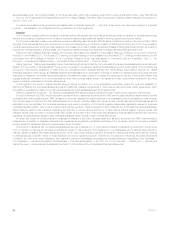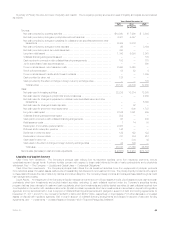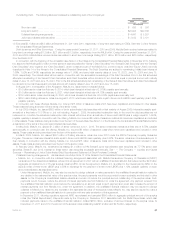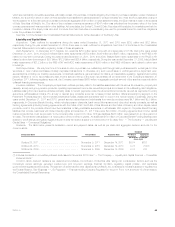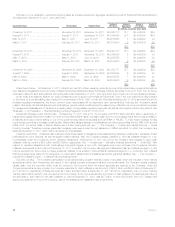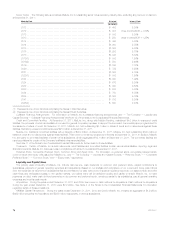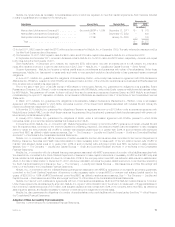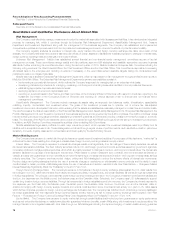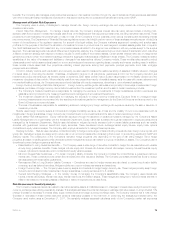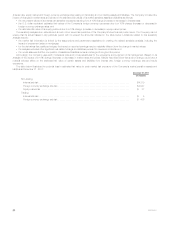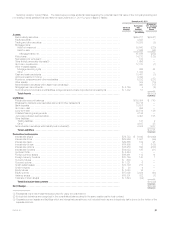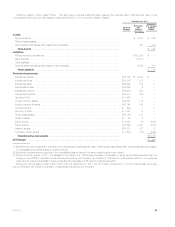MetLife 2011 Annual Report Download - page 77
Download and view the complete annual report
Please find page 77 of the 2011 MetLife annual report below. You can navigate through the pages in the report by either clicking on the pages listed below, or by using the keyword search tool below to find specific information within the annual report.Operating leases — As a lessee, the Company has various operating leases, primarily for office space. Contractual provisions exist that could
increase or accelerate those lease obligations presented, including various leases with early buyouts and/or escalation clauses. However, the impact of
any such transactions would not be material to the Company’s financial position or results of operations. See Note 16 of the Notes to the Consolidated
Financial Statements.
Other — Other liabilities presented in the table above are principally comprised of amounts due under reinsurance agreements, payables related to
securities purchased but not yet settled, securities sold short, accrued interest on debt obligations, estimated fair value of derivative obligations, deferred
compensation arrangements, guaranty liabilities, the estimated fair value of forward stock purchase contracts, the liability related to securitized reverse
residential mortgage loans, and general accruals and accounts payable due under contractual obligations. If the timing of any of the other liabilities is
sufficiently uncertain, the amounts are included within the one year or less category.
The other liabilities presented in the table above differ from the amount presented in the consolidated balance sheet by $5.6 billion due primarily to
the exclusion of items such as legal liabilities, pension and postretirement benefit obligations, taxes due other than income tax, unrecognized tax
benefits and related accrued interest, accrued severance and employee incentive compensation and other liabilities such as deferred gains and losses.
Such items have been excluded from the table above as they represent accounting conventions or are not liabilities due under contractual obligations.
The net funded status of the Company’s pension and other postretirement liabilities included within other liabilities has been excluded from the
amounts presented in the table above. Rather, the amounts presented represent the discretionary contributions of $205 million expected to be made by
the Company to the pension plan in 2012 and the contributions of $109 million expected to be made by the Company to the postretirement benefit
plans during 2012. Virtually all contributions to the pension and postretirement benefit plans are made by the insurance subsidiaries of MetLife, Inc. with
little impact on MetLife, Inc.’s cash flows.
Excluded from the table above are unrecognized tax benefits and related accrued interest of $679 million and $235 million, respectively, for which
the Company cannot reliably determine the timing of payment. Current income tax payable is also excluded from the table.
Separate account liabilities are excluded from the table above. Generally, the separate account owner, rather than the Company, bears the
investment risk of these funds. The separate account assets are legally segregated and are not subject to the claims that arise out of any other business
of the Company. Net deposits, net investment income and realized and unrealized capital gains and losses on the separate accounts are fully offset by
corresponding amounts credited to contractholders whose liability is reflected with the separate account liabilities. Separate account liabilities are fully
funded by cash flows from the separate account assets and are set equal to the estimated fair value of separate account assets.
The Company also enters into agreements to purchase goods and services in the normal course of business; however, these purchase obligations
were not material to its consolidated results of operations or financial position at December 31, 2011.
Additionally, the Company has agreements in place for services it conducts, generally at cost, between subsidiaries relating to insurance,
reinsurance, loans and capitalization. Intercompany transactions have been eliminated in consolidation. Intercompany transactions among insurance
subsidiaries and affiliates have been approved by the appropriate insurance regulators as required.
Support Agreements. MetLife, Inc. and several of its subsidiaries (each, an “Obligor”) are parties to various capital support commitments,
guarantees and contingent reinsurance agreements with certain subsidiaries of MetLife, Inc. Under these arrangements, each Obligor, with respect to
the applicable entity, has agreed to cause such entity to meet specified capital and surplus levels, has guaranteed certain contractual obligations or has
agreed to provide, upon the occurrence of certain contingencies, reinsurance for such entity’s insurance liabilities. We anticipate that in the event that
these arrangements place demands upon the Company, there will be sufficient liquidity and capital to enable the Company to meet anticipated
demands. See “— MetLife, Inc. — Liquidity and Capital Uses — Support Agreements.”
Litigation. Putative or certified class action litigation and other litigation, and claims and assessments against the Company, in addition to those
discussed elsewhere herein and those otherwise provided for in the Company’s consolidated financial statements, have arisen in the course of the
Company’s business, including, but not limited to, in connection with its activities as an insurer, mortgage lending bank, employer, investor, investment
advisor and taxpayer. Further, state insurance regulatory authorities and other federal and state authorities regularly make inquiries and conduct
investigations concerning the Company’s compliance with applicable insurance and other laws and regulations.
The Company establishes liabilities for litigation and regulatory loss contingencies when it is probable that a loss has been incurred and the amount
of the loss can be reasonably estimated. For material matters where a loss is believed to be reasonably possible but not probable, no accrual is made
but the Company discloses the nature of the contingency and an aggregate estimate of the reasonably possible range of loss in excess of amounts
accrued, when such an estimate can be made. It is not possible to predict or determine the ultimate outcome of all pending investigations and legal
proceedings. In some of the matters referred to herein, very large and/or indeterminate amounts, including punitive and treble damages, are sought.
Although in light of these considerations, it is possible that an adverse outcome in certain cases could have a material adverse effect upon the
Company’s financial position, based on information currently known by the Company’s management, in its opinion, the outcome of such pending
investigations and legal proceedings are not likely to have such an effect. However, given the large and/or indeterminate amounts sought in certain of
these matters and the inherent unpredictability of litigation, it is possible that an adverse outcome in certain matters could, from time to time, havea
material adverse effect on the Company’s consolidated net income or cash flows in particular quarterly or annual periods.
MetLife, Inc.
Capital
Restrictions and Limitations on Bank Holding Companies and Financial Holding Companies. MetLife, Inc. and its insured depository institution
subsidiary, MetLife Bank, are subject to risk-based and leverage capital guidelines issued by the federal banking regulatory agencies for banks and bank
and financial holding companies. The federal banking regulatory agencies are required by law to take specific prompt corrective actions with respectto
institutions that do not meet minimum capital standards. As of their most recently filed reports with the federal banking regulatory agencies, all of MetLife,
Inc.’s and MetLife Bank’s risk-based and leverage capital ratios met the federal banking regulatory agencies, “well capitalized” standards. In addition to
requirements which may be imposed in connection with the implementation of Dodd-Frank, such as the enhanced prudential standards under
proposed Regulation YY, if adopted in the U.S., Basel III will also lead to increased capital and liquidity requirements for bank holding companies, such
as MetLife, Inc. See “Business — U.S. Regulation,” “— Industry Trends” and “Risk Factors — Our Insurance, Brokerage and Banking Businesses Are
Highly Regulated, and Changes in Regulation and in Supervisory and Enforcement Policies May Reduce Our Profitability and Limit Our Growth” in the
2011 Form 10-K.
Once MetLife Bank has completely exited its depository business, MetLife, Inc. plans to terminate MetLife Bank’s FDIC insurance, putting MetLife,
Inc. in a position to be able to deregister as a bank holding company. Upon completion of the foregoing, MetLife, Inc. will no longer be regulated as a
bank holding company. However, if, in the future, MetLife, Inc. is designated by the FSOC as a non-bank systemically important financial institution,it
would once again be regulated by the Federal Reserve (including its capital requirements) and may be subject to enhanced supervision and prudential
MetLife, Inc. 73



